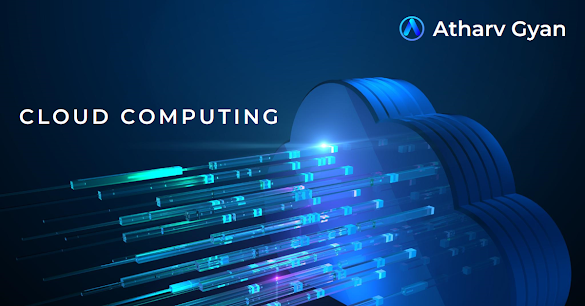A Comprehensive Guide to Cloud Computing
1. Definition and Concept of Cloud Computing:
Definition: Cloud computing refers to the delivery of computing services, including storage, processing power, and software, over the internet ("the cloud"). Instead of owning and maintaining physical servers and infrastructure, users can access and utilize these resources on a pay-as-you-go basis, scaling their usage up or down as needed.

Concept:
- On-Demand Self-Service: Users can provision and manage computing resources as needed, without requiring human intervention from the service provider.
- Broad Network Access: Services are available over the network and can be accessed through various devices (e.g., laptops, smartphones).
- Resource Pooling: Resources are shared among multiple users, with the provider dynamically assigning and reallocating them based on demand.
- Rapid Elasticity: Resources can be rapidly and elastically scaled up or down to accommodate changing workloads.
- Measured Service: Usage is monitored, controlled, and reported, providing transparency for both the provider and the consumer.
Example: Consider a company that needs to host a website. Instead of investing in physical servers, they can use a cloud service like Amazon Web Services (AWS) to rent virtual servers, storage, and other necessary resources. This allows them to scale their infrastructure based on website traffic without the upfront costs of buying and maintaining hardware.
2. Historical Evolution and Emergence:
Historical Evolution:
- 1950s-1960s: Mainframe computing - centralized processing for multiple users.
- 1970s-1980s: Rise of personal computers.
- 1990s: Client-server architecture becomes popular.
Emergence of Cloud Computing:
- Early 2000s: Internet-based services and grid computing.
- Mid-2000s: Virtualization technologies enable resource abstraction.
- 2006: Amazon Web Services (AWS) launches, marking the beginning of mainstream cloud computing.
- Subsequent Years: Other major cloud providers (Microsoft Azure, Google Cloud) enter the market.
Example: The emergence of cloud computing can be traced back to the early 2000s when companies recognized the potential of delivering computing resources over the internet. AWS played a pivotal role by offering a suite of cloud services, leading to a shift from traditional on-premises infrastructure to scalable and flexible cloud-based solutions.
This historical evolution showcases how technological advancements and the growing demand for scalable, cost-effective solutions contributed to the rise of cloud computing.
2. Key Characteristics:
On-demand self-service: Users can provision computing resources, such as server instances or storage, as needed without requiring human intervention. Example: Launching a virtual machine on a cloud platform like AWS.
Broad network access: Services are accessible over the network and can be accessed through standard mechanisms. Example: Accessing cloud-based applications through web browsers or APIs.
Resource pooling: Resources are shared among multiple users, providing economies of scale. Example: Multiple users sharing virtualized server resources on the same physical hardware.
Rapid elasticity: Resources can be quickly scaled up or down based on demand. Example: Increasing the number of virtual machines during a traffic spike and reducing them during low-demand periods.
Measured service: Cloud resources usage is monitored, controlled, and billed based on consumption. Example: Pay-as-you-go pricing models where users are billed for the actual resources they use.
3. Service Models:
Infrastructure as a Service (IaaS): Provides virtualized computing resources over the internet. Example: AWS EC2 allows users to rent virtual machines.
Platform as a Service (PaaS): Offers a platform that includes infrastructure, development tools, and services.
Example: Google App Engine for developing and hosting web applications.
Software as a Service (SaaS): Delivers software applications over the internet. Example: Using Microsoft Office 365 for word processing and collaboration.
Function as a Service (FaaS): Executes functions in response to events without the need to manage the underlying infrastructure. Example: AWS Lambda for serverless computing.
4. Deployment Models:
Public Cloud: Services are provided over the internet and available to the general public. Example: AWS, Azure, or GCP.
Private Cloud: Operated solely for an organization, offering more control over resources. Example: A company using OpenStack for an in-house private cloud.
Hybrid Cloud: Combines public and private cloud services. Example: Using a public cloud for scalable computing and a private cloud for sensitive data.
Community Cloud: Shared by several organizations with common concerns. Example: Educational institutions sharing a cloud for research purposes.
This is a brief overview, and each point can be explored in more detail. If you have specific questions or need more examples, feel free to ask!
5. Cloud Infrastructure Components:
Servers and Virtualization: Physical servers are virtualized to create multiple virtual machines, optimizing resource utilization. Example: VMware providing server virtualization solutions.
Networking (SDN): Software-Defined Networking enables programmable and efficien network management. Example: Cisco's ACI (Application Centric Infrastructure).
Storage (Object Storage, Block Storage): Various storage solutions cater to different needs, like object storage for scalable data and block storage for high-performance applications. Example: AWS S3 for object storage and EBS for block storage.
Data Centers: Facilities housing servers, networking equipment, and storage components. Example: Google's data centers powering its cloud infrastructure.
6. Cloud Service Providers:
Amazon Web Services (AWS): Offers a comprehensive suite of cloud computing services. Example: Netflix using AWS for its streaming services.
Microsoft Azure: Microsoft's cloud platform providing a range of services. Example: Coca-Cola using Azure for its digital transformation.
Google Cloud Platform (GCP): Google's cloud services, including computing, storage, and machine learning. Example: Spotify leveraging GCP for its music streaming platform.
IBM Cloud: IBM's cloud services emphasizing hybrid and AI solutions. Example: American Airlines using IBM Cloud for its digital transformation.
Oracle Cloud: Oracle's cloud services focusing on databases and enterprise applications. Example: Zoom using Oracle Cloud to support its video conferencing platform.
7. Cloud Security:
Data Encryption: Ensuring data confidentiality through encryption algorithms. Example: Encrypting sensitive data stored in a cloud database.
Identity and Access Management: Managing user access to resources securely. Example: Implementing multi-factor authentication for cloud services.
Compliance and Regulations: Adhering to industry-specific regulations and compliance standards. Example: Healthcare organizations ensuring HIPAA compliance in the cloud.
Security Best Practices: Implementing recommended security measures to protect against threats. Example: Regularly updating and patching cloud systems to address vulnerabilities.
8. Advantages of Cloud Computing:
Cost Savings: Paying for resources used, avoiding upfront infrastructure costs. Example: Startups benefiting from cloud scalability without heavy initial investments.
Scalability and Flexibility: Easily scaling resources up or down based on demand. Example: Retailers handling increased website traffic during holiday sales.
Accessibility and Mobility: Accessing data and applications from anywhere with an internet connection. Example: Remote teams collaborating through cloud-based tools.
Automatic Updates: Providers handle software updates, ensuring the latest features and security patches. Example: Cloud applications automatically updating without user intervention.
9. Challenges and Risks:
Security Concerns: Concerns about data breaches and unauthorized access. Example: Targeted cyberattacks on cloud infrastructure.
Downtime and Reliability: Service interruptions impacting business operations. Example: Cloud outages affecting online services.
Compliance Challenges: Meeting specific industry and regional compliance requirements. Example: Financial institutions complying with regulations like GDPR.
Data Privacy: Concerns about the privacy and ownership of data in the cloud. Example: Legal issues surrounding the storage and handling of personal data.
This provides a comprehensive overview of the topics you requested. If you have more specific questions or want further details on any section, feel free to ask!
10. Cloud Computing Use Cases:
Web Hosting and Development: Hosting websites and applications in the cloud for easy scalability. Example: WordPress websites hosted on AWS.
Big Data Analytics: Processing and analyzing large datasets for insights. Example: Netflix using cloud-based analytics for content recommendations.
Internet of Things (IoT): Managing and analyzing data from connected devices. Example: Smart cities using cloud platforms to process IoT data for urban planning.
Artificial Intelligence and Machine Learning: Utilizing cloud resources for AI and ML model training and deployment. Example: Google Cloud AI Platform for machine learning projects.
11. Cloud Migration Strategies:
Rehosting (Lift and Shift): Migrating applications without major changes. Example: Moving existing virtual machines to the cloud.
Refactoring (Replatforming): Adapting applications for cloud services. Example: Rewriting parts of an application to use cloud-native databases.
Rearchitecting: Redesigning applications to leverage cloud-native features fully. Example: Containerizing applications for scalable deployment.
Rebuilding: Rewriting applications from scratch for the cloud. Example: Developing a new microservices architecture in the cloud.
Replacement: Adopting new cloud-based software instead of existing on-premises solutions. Example: Transitioning from in-house email servers to cloud-based email services.
12. Case Studies:
Netflix: Utilizes AWS for its streaming platform, leveraging the cloud's scalability for a global user base.
Zoom: Relies on Oracle Cloud to support its video conferencing services, ensuring high performance and reliability.
Airbnb: Uses AWS for hosting its website and managing large amounts of user data for bookings.
Thakur Cloud: Uses own cloud services for hosting its website and managing large amounts of user data for domains, hosting and website builders services. Thakur Cloud
13. Future Trends in Cloud Computing:
Edge Computing: Processing data closer to the source to reduce latency. Example: IoT devices processing data locally before sending it to the cloud.
Serverless Computing: Executing functions without managing the underlying infrastructure. Example: AWS Lambda for event-driven computing.
Multi-Cloud Strategies: Distributing workloads across multiple cloud providers. Example: Companies using both AWS and Azure for different aspects of their operations.
Quantum Computing: Exploring the potential of quantum computing for solving complex problems. Example: IBM Quantum for quantum computing research.
Share
Tags
